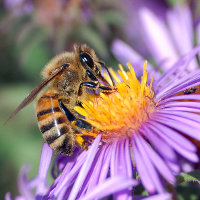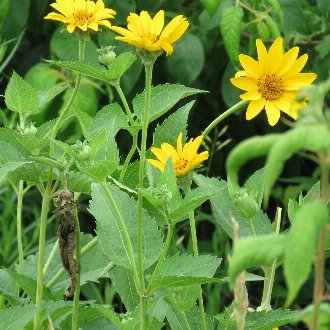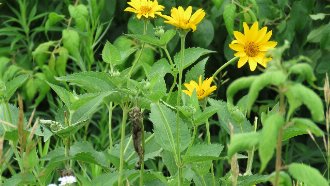False Sunflower (Heliopsis helianthoides (L.) Sweet)
Also known as smooth oxeye, rough oxeye, oxeye sunflower, western sunflower-everlasting, western oxeye, eastern sunflower-everlasting, eastern oxeye; also classified as Buphthalmum helianthoides L.
We follow POWO's convention of recognizing two varieties of this species, var. helianthoides and var. scabra. USDA PLANTS recognizes an additional two, var. occidentalis and var. gracilis. Per POWO's treatment, we lump var. occidentalis in with var. scabra, and we treat var. gracilis as its own species, pinewoods oxeye (Heliopsis gracilis).
↑Summary
A perennial with yellow, sunflower-like flowers, hence the one common name. Native to a wide range of North America, from the southwest to the northeast; generally more abundant in the north.
↑Range - Expand
| Legend | Color |
| Native | |
| Expanded | |
| Native or Not Present | |
| Native or Expanded |
This tentative map is based on our own research. It may have limited data on Canada and/or Mexico, and there is some subjectivity in our assignment of plants as introduced vs. expanded. Read more in this blog post.
Although this plant occurs somewhere in each of these regions, it may only occur in a small part of some or all of them.
This species is widely planted in gardens and sometimes escapes, but it also has vigorous wild populations spreading on its own. It is expanding its range in the northeast, contiguously with its native range, likely with significant help from humans.
↑Habitat
Heliopsis helianthoides is found in a variety of moist-to-mesic, sunny to partly-sunny sites, often at the border of open and wooded habitats. Natural habitats include black soil prairies, wet meadows (often in floodplains), open woodlands, larger woodland clearings, savannas, and streambanks. It is also common in anthropogenic habitats, including areas along railroads and roadsides, especially where there is some sort of ecotone between natural and anthropogenic habitats, such as prairie remnants along railroad tracks, or small woodland fragments in urban or suburban areas.
It is most abundant in the eastern portions of the Great Plains, and is also common in the mountains in the Southern Appalachians, but becomes increasingly uncommon to rare in the southeastern Piedmont and into the coastal plain. In the southeast of its range it is often associated with tuliptrees and restricted to richer sites. It is increasing its range in the northeast, in part due to garden escapes.
It tolerates a significant amount of rocks and clay in the soil, but prefers loamy soil rich in organic matter. It tolerates temporary waterlogging and sites that occasionally experience flooding, but is absent from the lower sites that flood more frequently and take longer to drain.
In forested areas it is limited to sites with some degree of vegetation-removing disturbance, but it can persist long-term in stable grasslands.
The two widely-recognized varieties differ in their habitat preferences. The more eastern var. helianthoides prefers moister, shadier conditions, usually in bottomlands and borders and openings in moist forests. The western var. scabra ranges into sunnier, drier habitats, and is found in prairies and borders and openings in upland woods, and is more tolerant of sandy soil.
↑Life Cycle
Heliopsis is a perennial with long bloom period. Plants are short-rhizomatous with a clumping habit; clumps become more vigorous over time on favorable sites, but plants rely on seeds for long-distance dispersal.
Plants may not flower in their first year, or may produce a single flower or few flowers in favorable conditions. First-year plants rarely reach their maximum height, often being only a few inches tall. Second-year plants usually reach their full height, but not their maximum vigor. Healthy clumps will grow more stems in subsequent years.
The bloom period begins in summer and continues throughout the remainder of the growing season, with seed maturing incrementally and the plant often continuing to grow new flowers up until halted by cold temperatures. As such, this species takes advantage of years with warm temperatures in late fall, at the cost of reduced seed production in years where cold temperatures hit early.
Mortality can occur through a wide variety of factors, including drought, prolonged flooding, competition from other herbaceous plants, or canopy closure from overhead trees or shrubs. We could not find information about the typical lifespan of this plant in the wild. It is likely highly variable based on conditions, as this species can occur both in habitats where its preferred conditions are transient, and those where these conditions persist long-term.
↑Faunal Associations
This species supports a large number and variety of insects. Aphids typically feed on the stem in large numbers, and in turn support birds and insect predators.
↑Uses
This plant is sometimes planted in gardens, especially those focused on native plants. Some cultivars exist, including ones with more compact growth habits. It is valued for its showy flowers, long bloom period, and being generally easy to grow, tolerating a wide range of conditions. In the garden, this species can be grown in drier conditions than it would occur in in the wild.
It is also frequently used in ecological restoration projects and mass plantings, where it is valued for many of the same reasons, including that it is relatively easy to seed into an area and is often competitive against invasives.
↑Related Plants
There are a few other Heliopsis species native to North America.
The broader Heliantheae or sunflower tribe of the Asteraceae family contains numerous species.
↑Notes
We prefer the common name "false sunflower" as this species does bear close resemblance to true sunflowers (Helianthus sp.) but does not belong to this genus. The common names "smooth oxeye" (used more commonly) and "rough oxeye" are confusing in that they sound like they would refer to different species, but they both refer to this same species. "Smooth oxeye" also can refer to pinewoods oxeye (Heliopsis gracilis) and is thus ambiguous. The name "oxeye sunflower" is also misleading as this species is not a true sunflower.
Furthermore, the common names with the term "oxeye" may also be misleading as that name is used to refer to a number of other plants in other genera, including, most-commonly, the oxeye daisy (Leucanthemum vulgare), as well as the sticky oxeye (Heteranthemis viscide-hirta), the beach creeping oxeye (Pascalia glauca), the bay biscayne creeping-oxeye (Sphagneticola trilobata), and the coastal plain creepingoxeye (Wedelia fruticosa).
When varieties are recognized, the common names "eastern oxeye", "smooth oxeye", and "eastern sunflower-everlasting" refer to the eastern var. helianthoides, whereas the names "rough oxeye", "western oxeye", and "western sunflower-everlasting" refer to the western var. scabra.
↑Links & External Resources
• Heliopsis helianthoides (False Sunflower) | Illinois Wildflowers (About This Site)
• Heliopsis helianthoides (Smooth Oxeye) | USDA PLANTS Database (About This Site)
• Heliopsis helianthoides | Go Botany (About This Site)
• Heliopsis helianthoides (Oxeye Sunflower) | Missouri Botanical Garden Plant Finder (About This Site)
• Heliopsis helianthoides | Biota of North America Project (BONAP) (About This Site)
• Heliopsis helianthoides | NatureServe Explorer (About This Site)
• Heliopsis helianthoides | Flora of North America (About This Site)
• Heliopsis helianthoides | Missouri Plants (About This Site)
• Smooth Oxeye | Maryland Biodiversity Project (About This Site)
• Heliopsis helianthoides (Smooth Oxeye) | Minnesota Wildflowers (About This Site)
• Heliopsis helianthoides (L.) Sweet var. helianthoides (Oxeye, Smooth Oxeye) | Digital Atlas of the Virginia Flora (About This Site)




